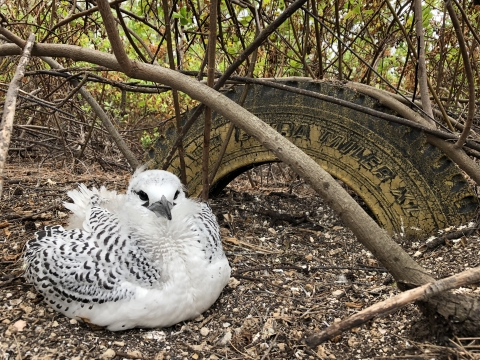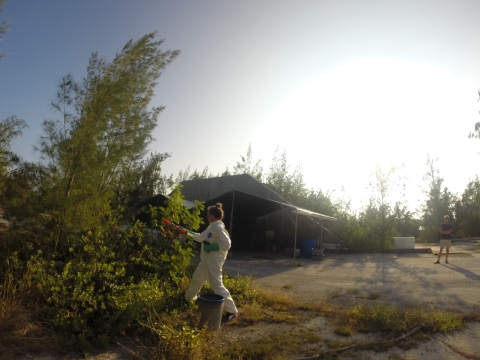About Us
Johnston Atoll National Wildlife Refuge is comprised of four islands (Johnston, Sand, North and East Island), and is located 716 nautical miles southwest of Honolulu. The formation of the atoll began 70 million years ago through a series of underwater volcanic eruptions.
Johnston and Sand Island were designated as federal bird refuges in 1926 and retained its status as a refuge after the U.S. Navy took control of it in 1934. By 1964 dredge and fill operations had increased the size of Johnston Island from 46 acres to 596 acres. Sand Island was increased from 10 acres to 22 acres, and the addition of 25 acres of North Island and 18 acres of East Island were added to the atoll.
Johnston Island played an important role in the United States’ nuclear testing program, which began in the late 1940s. From the late 1950s to 1962, high-altitude nuclear testing was carried out at Johnston Atoll. Chemical munitions were also stockpiled on Johnston and subsequently incinerated in the Johnston Atoll Chemical Agent Disposal System, that was built in 1990 and disassembled in 2004 after the completion of its mission. By November 2003, the U.S. Air Force completed clean-up and demolition of the incinerator buildings. By May 2005, almost all of Johnston Island's infrastructure had been removed, and all personnel left the atoll, including refuge staff.
On January 6, 2009, the Pacific Islands Heritage Marine National Monument was established, which included Johnston Atoll National Wildlife Refuge within its boundaries. By secretary’s order, the boundaries of the Monument were established at 50 nautical miles out from the islands shoreline. On September 25, 2014, the monument was expanded around Johnston Atoll out to 200 nautical miles. The U.S. Air Force retains administrative jurisdiction over emergent lands at Johnston Atoll; however, the atoll is managed as a national wildlife refuge national wildlife refuge
A national wildlife refuge is typically a contiguous area of land and water managed by the U.S. Fish and Wildlife Service for the conservation and, where appropriate, restoration of fish, wildlife and plant resources and their habitats for the benefit of present and future generations of Americans.
Learn more about national wildlife refuge .
Our Mission
The mission of the National Wildlife Refuge System is to administer a national network of lands and waters for the conservation, management and, where appropriate, restoration of the fish, wildlife and plant resources and their habitats within the United States for the benefit of present and future generations of Americans.
Our History
- 1903 March 14 - President Theodore Roosevelt implements the first National Wildlife Refuge on Pelican Island, Florida.
- 1926 July 29 - By way of Executive Order 4467, President Calvin Coolidge establishes Johnston Atoll as a federal bird refuge and places it under the control of the U.S. Department of Agriculture.
- 1934 December 29 - President Franklin D. Roosevelt places Johnston Atoll under the control and jurisdiction of the U.S. Navy (while maintaining it as a national wildlife refuge national wildlife refuge
A national wildlife refuge is typically a contiguous area of land and water managed by the U.S. Fish and Wildlife Service for the conservation and, where appropriate, restoration of fish, wildlife and plant resources and their habitats for the benefit of present and future generations of Americans.
Learn more about national wildlife refuge ) until 1948 when the U.S. Air Force takes control. - 2009 January 6 - The Pacific Islands Heritage Marine National Monument is established, which expanded the protected boundaries of Johnston Atoll out to 50 miles.
- 2010 - U.S. Fish and Wildlife Service identifies a yellow crazy ant invasion on Johnston Island. The ants are found blinding and maiming ground nesting red-tailed tropicbirds, and efforts to eradicate the ants begin.
- 2014 September 25 - The Pacific Islands Heritage Marine National Monument is expanded. The protection around Johnston Atoll now extends out to 200 nautical miles.
- 2021 - After almost 11 years of hard work by dedicated staff and volunteers, the U.S. Fish and Wildlife Service announces eradication of the invasive yellow crazy ant from Johnston Island.
Other Facilities in this Complex
While Johnston Atoll National Wildlife Refuge is not a complex, it does fall within the Pacific Remote Islands Marine National Monument. The monument incorporates approximately more than 490,000 square miles within its boundaries, which extend 50 nautical miles from the mean low water lines of Howland and Baker Islands, Kingman Reef, and Palmyra Atoll, and can extend as far out as 200 nautical miles at Johnston and Wake Atolls, and Jarvis Island.





